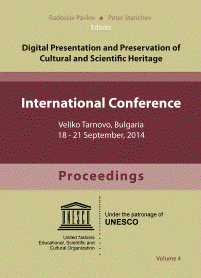Linked Data, JSON-LD and the Semantics of Cultural and Scientific Heritage
DOI:
https://doi.org/10.55630/dipp.2014.4.11Keywords:
cultural and scientific heritage, linked data, JSON-LD, web semantics, E-DemocracyAbstract
This paper discusses the importance of linked data for the semantics of cultural and scientific heritage and it provides some reasons on using JSON- LD as a standard. From a conceptual point of view, cultural and scientific heritage should widen for broad human and computer access. Web semantics support the transformation of information to knowledge on a large and open scale and cultural and scientific heritage should benefit from that, especially if we see the latter as a pillar in a lean system, such as E-Democracy that seeks for permanent improvement. Cultural and scientific heritage has a primary role in education of individuals but also in the optimization process of knowledge society through the humane collective approach of trial and error. In order to build a society of inclusion using vertical (temporal) and horizontal (spatial) inquiries in social values, religions, beliefs and rituals we must facilitate broaden and less restrictive access. One way to achieve this task is by using linked data for connectivity and meaning of information and the standard of JSON-LD for extensive and simple digital access.References
Antoniou, G., & Harmelen, F. v. (2008). A Semantic Web Primer (2nd ed.). London, UK: The MIT Press.
Báez, A., & Herrero, L. C. (2012). Using contingent valuation and cost-benefit analysis to design a policy for restoring cultural heritage. Journal of Cultural Heritage , 13 (3), 235- 245.
Baker, K. (2013). Information literacy and cultural heritage: developing a model for lifelong learning. Oxford, UK: Chandos Publishing.
Castells, M. (2005). The Network Society: from Knowledge to Policy . In M. Castells, & G. Cardoso (Eds.), The Network Society: From Knowledge to Policy (pp. 3-22). Washington, DC: Center for Transatlantic Relations.
Fielding, R. T. (2000). Architectural Styles and the Design of Network-based Software Architectures. University of California, Information and Computer Science. Irvine: https://www.ics.uci.edu/~fielding/pubs/dissertation/fielding_dissertation.pdf.
Heath, T., & Bizer, C. (2011). Linked Data: Evolving the Web into a Global Data Space. (J. Hendler, Ed.) Ebook: Morgan & Claypool Publishers.
Hinchcliffe, D. (2009, September 7). Web-Oriented Architecture (WOA). Retrieved May 1, 2014, from InfoQ: http://www.infoq.com/presentations/Web-Oriented-Architecture- Dion-Hinchcliffe
Lee, J.-S. (2014). Measuring the benefits of the Intangible Cultural Heritage Hall in Jeonju Korea: Results of a Contingent Valuation Survey. Journal of Cultural Heritage, http://dx.doi.org/10.1016/j.culher.2014.05.001.
Sporny, M. (2014, January ). Retrieved from JSON-LD and Why I Hate the Semantic Web: http://manu.sporny.org/2014/json-ld-origins-2/
Turcoane, O. (2013). E-Democracy's Representatives, A Proposal And A Case Study. Econ-omy Informatics , 13 (1), 73-90.
World Wide Web Consortium. (2014, January). Retrieved from JSON-LD 1.0: http://www.w3.org/TR/json-ld/
World Wide Web Consortium. (2014, February). Retrieved from RDF 1.1 Concepts and Ab-stract Syntax: http://www.w3.org/TR/2014/REC-rdf11-concepts-20140225/




